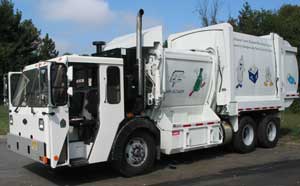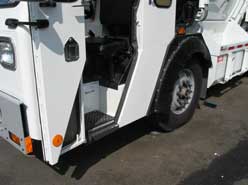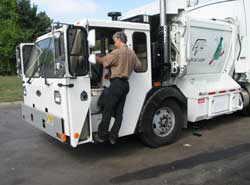Recycling Collector Dies After Falling Under the Wheels of His Truck
New Jersey Case Report: 05NJ077
Report Date: August 24, 2006
Summary
On September 2, 2005, a 26-year-old Hispanic recycling collector was killed when he was run over by a recycling truck. The victim worked for a non-profit company that collected recyclable household materials such as bottles and cans. A crew of three was assigned to a new recycling truck, a large commercial vehicle similar to a traditional garbage truck except that recyclables were deposited into bins on the sides of the truck. The crew had just completed collecting recyclables along a residential street and the driver was backing the truck to turn down the next street. The victim stood near the rear of the truck to spot for the driver as he backed up. After completing the maneuver, the driver called for the victim to jump onto the truck so they could drive to the next pick-up. The victim jumped onto a small step leading up to the driver’s seat and grabbed two metal handles as the driver pulled away. Almost immediately, the victim fell from the truck and was run over by the front wheels of the truck, with his legs and pelvis trapped underneath the tire. The driver backed the truck off the victim and called 911 for help. The victim was transported to the local hospital, where he died of his injuries later that morning. NJ FACE investigators recommend following these safety guidelines to prevent similar incidents:
- All employees should be trained to safely operate and use the different types of collection vehicles.
- Employers should follow the recommendations in the NIOSH Alert, Preventing Worker Injuries and Deaths From Moving Refuse Collection Vehicles.
- Employers should conduct a job hazard analysis of all work activities with the participation of the workers.
Introduction
On September 6, 2005, NJ FACE staff received a newspaper article about a Hispanic recycling collector who was killed after falling from and being run over by a recycling truck. A NJ FACE investigator initiated an investigation the following day, conferring with OSHA to determine if the incident was in-scope. The FACE investigator contacted the victim’s employer to request participation in a field investigation, which was conducted on October 5, 2005. During the visit, NJ FACE investigators interviewed the company safety representative and the driver involved in the incident. The recycling truck and the incident site were also examined. Additional information on the incident was obtained from the police report, the medical examiner’s report, and the OSHA investigation file.
The victim’s employer was a non-profit, vocational training center that primarily employed people with disabilities. The center had been in operation since 1964 and had a number of programs for both disabled and able-bodied (not disabled) workers by providing labor for the county recycling program, as well as light assembly, custodial, cleaning, and other services. The center also employed persons who were required to pay restitution as part of a conviction for minor crimes and other offenses. The company employed 756 workers, 114 of whom worked in the recycling center. Most of the workers were unionized. A full-time bilingual safety person led monthly safety meetings with classroom videos and discussion. Job training included new employee orientation, classroom, and supervised on-the-job training.
The victim was a 26-year-old white Hispanic male recycling collector who had worked for the company for over six months. He was an able-bodied employee who was a member of the union. He had completed his job training and was twice observed working satisfactorily by his supervisors. The victim was survived by his wife and two children.
This employer had previously participated in a NJ FACE investigation of a company worker who had been killed in a newspaper baling machine (see NJ FACE report 95-NJ-108pdf iconexternal icon). The company had also assisted NJ FACE personnel with writing a hazard alert bulletin, Don’t Get Hurt Working Around Sanitation Trucks. (Link updated 3/26/2009)
Back to Top
Investigation
The employer’s recycling program was first initiated in 1982 following an agreement with the county to take over the subcontracted recycling work. The program was successful, and a 20-year agreement was signed in 1995 to provide recycling services throughout the county’s 40 municipalities. A state of the art recycling center was built which allowed the employer to expand into collecting plastics in addition to tin, aluminum, glass, and paper products. The company also supported a bulk waste recycling program based at the local landfill that collects tires, metal, and wood waste.
Most of the recycling operations were operated out of the recycling center. This was a large, modern industrial complex designed to receive, separate, bale, and ship recyclable materials. The center supported a fleet of 35 recycling and sanitation trucks. The trucks were dispatched on routes throughout the county and were scheduled to pick up recyclable materials in each neighborhood every two weeks. Residents commingled the different recyclable materials together into large plastic recycling containers that resemble garbage cans. The collection crews emptied the containers into the trucks, which are of side-loading or rear-loading design. Once full, the trucks were driven back to the recycling center and emptied. The various materials were separated by machine and by hand, then baled and sold to raw material manufacturers. Approximately 200 tons of recycled materials were processed daily by the facility.
The incident occurred on Friday, September 2, 2005. The workers arrived at the recycling center at their usual start time of 7:00 a.m. An extra run was needed to collect additional recyclable materials to make a quota, so a crew was assembled. The usual driver was absent that day, and a supervisor was assigned to fill in for him. This supervisor was an experienced driver with a commercial driver’s license. The rest of the crew included the victim and a second collector, a 33-year-old laborer who had worked for the center for two weeks. At approximately 7:30 a.m., the supervisor drove a truck with the laborers to the county jail to pick up a few items, which they unloaded back at the recycling center. The crew then boarded the collection truck they were to use that day.
This truck was a new vehicle that had been in service for two months and had only been used about ten times. The chassis was designed with the cab located forward of the front tires, allowing the cab to be low to the ground for easy entry. The cab was equipped with bi-fold doors on each side that could remain open during operation. The doorways were equipped with large handrails and a small step for entering the truck. The cab had seating for three people, and both the driver’s and passengers’ seats could be folded down for easy entry and exit. This allowed the truck to be operated from a standing position so the driver could easily leave the cab to collect. Mounted to the was a collecting and compacting device, which had been built by a different manufacturer than the truck chassis. This device was designed to be side-loading, with large bins mounted to each side of the truck. The collectors would deposit recyclables into the bins and then would activate a mechanism that raised the bins to the top of the truck where the contents were dumped into the truck’s compactor.

|
|
|
Photo 1. Recycling Collection Truck
|
|

|

|
|
Photo 2. Entry Step to Recycling Truck
|
Photo 3. Position of Victim on Entry Step
|
This truck usually ran with a crew of two, where the driver would also collect recyclables. On this occasion, the driver/supervisor took an additional worker in order to do the job faster. After leaving the recycling center, the crew stopped for coffee at a convenience store before starting their collection route. The weather was clear, with a reported temperature of 78 °F as the crew collected along a wide residential avenue. Although this was the first time the crew worked together, the driver said that the team worked well. As they worked the route, they passed a street to the left before coming to a ‘T’ intersection that marked the end of the street. The driver prepared to back the truck to collect recyclables on the street they had just passed. The victim, wearing a florescent vest, stood behind the truck to spot for the driver as the second collector entered the passenger side of the truck. After backing the truck to the turn, the driver called for the victim to jump or hop onto the truck, which he did by standing on the small step leading to the cab and holding on to the metal handles beside the door. This step was not designed to be a riding step and was built only to access the truck cab. As the driver started to move forward to make the turn, the victim’s hands slipped off the handles and he fell forward of the turning front tire. The driver felt a bump and heard a popping noise and immediately heard the victim yell, “You’re on my legs!” The driver stopped the truck and put it in reverse to back off of the victim, who was lying face down on the road and bleeding from leg and pelvic injuries. The driver went to check on the victim and called 911 on his cell phone as the other laborer went to the nearby intersection to get help. The first 911 call was received at 9:41 a.m., and the first responding police units started first aid on the victim. EMS arrived and transported the victim to a schoolyard where he was picked up by a Medevac helicopter and airlifted to the regional trauma center. Despite treatment, the victim went into shock and was pronounced dead of his injuries at 12:48 p.m. that day.
Back to Top
Recommendations/Discussion
Recommendation #1: All employees should be trained to safely operate and use the different types of collection vehicles.
Discussion: The recycling center was using a new truck that had just been put into service. Most of the center’s 34 other trucks were equipped with riding steps for the collectors to stand on between pickups. This truck was designed without a riding step, and the crew was to ride in the passenger compartment between stops. However, the crew had apparently not been properly trained on this type of truck, and improvised by using misusing the entrance step as a riding step. To prevent future incidents, all employees should be trained on the safe use of all the different types of collection vehicles, including the use of riding steps, roadway collection procedures, compactor operation, and basic maintenance. This training may be reinforced by using safety signs that clearly identify riding and non-riding steps on each truck.
Recommendation #2: Employers should follow the recommendations in the attached NIOSH Alert, Preventing Worker Injuries and Deaths From Moving Refuse Collection Vehicles.
Discussion: After analyzing a number of deaths involving sanitation workers, NIOSH published an alert warning of the hazards of working on and around refuse collection vehicles. Although this incident did not involve a garbage truck, many of the NIOSH recommendations apply to this situation. These recommendations include developing a procedure for safely riding and backing the vehicles, only moving the vehicle when the workers are in sight, and developing a signaling system for communicating. It was noted that the recycling center already followed some of these procedures.
The NJDHSS pamphlet, Don’t Get Hurt Working Around Sanitation Trucks, has many of these recommendations written in a brief, easy-to-read format. This publication is available in both English and Spanish on the Internet at http://www.state.nj.us/health/surv/documents/sanwk_en.pdfpdf iconexternal icon. (Link updated 3/26/2009)
Recommendation #3: Employers should conduct a job hazard analysis of all work activities with the participation of the workers.
Discussion: To prevent incidents such as this, NJ FACE recommends that employers conduct a job hazard analysis (JHA) of all work areas and job tasks with the assistance of the employees. A job hazard analysis is a procedure that breaks down a job or task into specific steps, analyzes each step for specific hazards, and uses this information to develop safe work procedures to eliminate or reduce those hazards. A job hazard analysis should begin by reviewing the work activities that the employee is responsible for and the equipment that is needed. Each task is further examined for mechanical, electrical, chemical, or any other hazard that the worker may encounter. The results of the analysis can be used to design or modify the written standard operating procedures for the job. Additional information is available in the publication, Job Hazard Analysis, which is available on the federal OSHA web site at https://www.osha.gov/Publications/osha3071.pdfpdf iconexternal icon.
Recommended Resources
It is extremely important that employers obtain accurate information on health, safety, and applicable OSHA standards. NJ FACE recommends the following sources of information which should help both employers and employees:
U.S. Department of Labor, Occupational Safety & Health Administration (OSHA)
Federal OSHA will provide information on safety and health standards on request. OSHA has four area offices in New Jersey that cover the following counties:
Hunterdon, Middlesex, Somerset, Union, and Warren counties
Telephone: (732) 750-3270
Essex, Hudson, Morris, and Sussex counties
Telephone: (973) 263-1003
Bergen and Passaic counties
Telephone: (201) 288-1700
Atlantic, Burlington, Cape May, Camden, Cumberland, Gloucester, Mercer, Monmouth, Ocean, and Salem counties
Telephone: (856) 757-5181
Federal OSHA
Web site: https://www.osha.gov/external icon
New Jersey Public Employees Occupational Safety and Health (PEOSH) Program
The PEOSH Act covers all NJ state, county, and municipal employees. Two state departments administer the act; the NJ Department of Labor and Workforce Development (NJDLWD), which investigates safety hazards, and the NJ Department of Health and Senior Services (NJDHSS) which investigates health hazards. PEOSH has information available that may also benefit private employers.
NJDLWD, Office of Public Employees Safety
Telephone: (609) 633-3896
Web site: http://lwd.dol.state.nj.us/lsse/employer/Public_Employees_OSH.htmlexternal icon (Link updated 3/26/2013)
NJDHSS, Public Employees Occupational Safety & Health Program
Telephone: (609) 984-1863
Web site: http://www.state.nj.us/health/eoh/peoshweb/external icon
New Jersey Department of Labor and Workforce Development, Occupational Safety and Health On-Site Consultation Program
This program provides free advice to private businesses on improving safety and health in the workplace and complying with OSHA standards.
Telephone: (609) 984-0785
Web site: http://lwd.dol.state.nj.us/labor/lsse/employer/Occupational_Safety_
and_Health_Onsite_Consultation_Program.htmlexternal icon (Link updated 3/26/2009)
New Jersey State Safety Council
The NJ State Safety Council provides a variety of courses on work-related safety. There is a charge for the seminars.
Telephone: (908) 272-7712.
Web site: http://www.njsafety.orgexternal icon
Internet Resources
Other useful internet sites for occupational safety and health information:
- CDC/NIOSH – https://www.cdc.gov/niosh/
- Employment Laws Assistance for Workers and Small Businesses – http://www.dol.gov/elaws/external icon
- National Safety Council – http://www.nsc.org/Pages/Home.aspxexternal icon (Link updated 11/17/2009)
- American National Standards Institute (ANSI) – http://www.ansi.orgexternal icon
- Product recall information – http://www.recalls.govexternal icon
- NJDHSS FACE reports – http://www.state.nj.us/health/eoh/survweb/face.htmexternal icon
- CDC/NIOSH FACE – https://www.cdc.gov/niosh/face/
References
- NIOSH Alert: Preventing Worker Injuries and Deaths From Moving Refuse Collection Vehicles. DHHS NIOSH Publication No. 97-110, NIOSH Publications Dissemination, 4676 Columbia Parkway, Cincinnati, OH 45226-1998. Telephone: (800) 356-4674, FAX (515) 533-8573
- Job Hazard Analysis. U.S. Department of Labor Publication # OSHA-3071, 2002 (revised). U.S. Department of Labor, OSHA Publications, P.O. Box 37535, Washington D.C. 20013-7535
Telephone: (202) 693-1888, Fax: (202) 693-2498 - Don’t Get Hurt Working Around Sanitation Trucks. E. O’Hagan, NJ Department of Health & Senior Services, Trenton NJ 08625
New Jersey FACE Program
Fatality Assessment and Control Evaluation (FACE) Project
Investigation # 05-NJ-077
Staff members of the New Jersey Department of Health and Senior Services, Occupational Health Service, perform FACE investigations when there is a report of a targeted work-related fatal injury. The goal of FACE is to prevent fatal work injuries by studying the work environment, the worker, the task and tools the worker was using, the energy exchange resulting in the fatal injury, and the role of management in controlling how these factors interact. FACE gathers information from multiple sources that may include interviews of employers, workers, and other investigators; examination of the fatality site and related equipment; and reviewing OSHA, police, and medical examiner reports, employer safety procedures, and training plans. The FACE program does not determine fault or place blame on employers or individual workers. Findings are summarized in narrative investigation reports that include recommendations for preventing similar events. All names and other identifiers are removed from FACE reports and other data to protect the confidentiality of those who participate in the program.
NIOSH-funded state-based FACE Programs include: Alaska, California, Iowa, Kentucky, Massachusetts, Michigan, Minnesota, Nebraska, New Jersey, New York, Oklahoma, Oregon, Washington, West Virginia, and Wisconsin. Please visit the NJ FACE web site at http://www.state.nj.us/health/eoh/survweb/face.htmexternal icon or the CDC/NIOSH FACE web site at https://www.cdc.gov/niosh/face/ for more information.
This NJ FACE report is supported by Cooperative Agreement # 5 U60 OH0345-02 from the Centers for Disease Control and Prevention (CDC). Its contents are solely the responsibility of the authors and do not necessarily represent the official views of the CDC.
To contact New Jersey State FACE program personnel regarding State-based FACE reports, please use information listed on the Contact Sheet on the NIOSH FACE web site. Please contact In-house FACE program personnel regarding In-house FACE reports and to gain assistance when State-FACE program personnel cannot be reached.

